Terry Odell's Blog, page 272
September 16, 2011
Friday Field Trip - Memorial Forest
Here are some more shots from the Memorial Forest. I tended to take vistas; Hubster got up close and personal. (And, of course he has to include the obligatory mushroom)
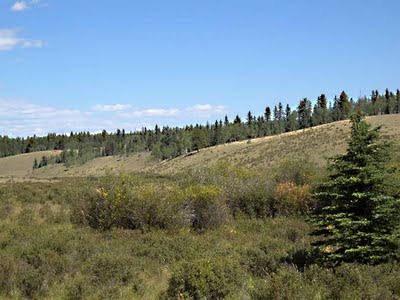
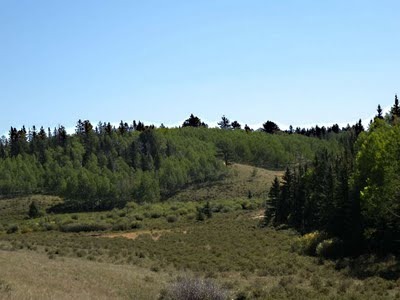
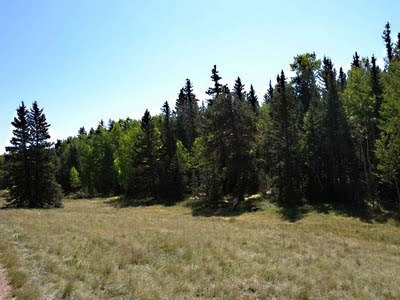
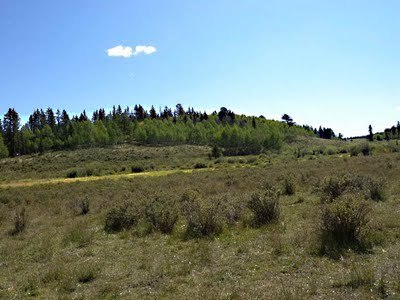



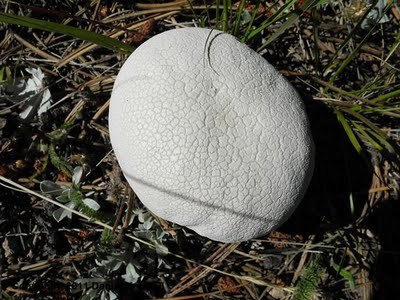
Like this post? Please share by clicking one of the links below. And don't forget, my goal is 500 followers by the end of the year, and 250 "likes". There will be prizes when I get to each milestone.








Like this post? Please share by clicking one of the links below. And don't forget, my goal is 500 followers by the end of the year, and 250 "likes". There will be prizes when I get to each milestone.
Published on September 16, 2011 04:00
September 15, 2011
Blog Q&A
Blogging. I've been here at Blogger since July of 2006. This was my first post.
 The template I used was a lot different then, but as Blogger updates, it's "retroactive" so you can't see how bare bones my early blog page was.
The template I used was a lot different then, but as Blogger updates, it's "retroactive" so you can't see how bare bones my early blog page was.
I've got some questions at the end of this post, and would appreciate your feedback. I hope you'll take a moment to comment.
A while back, there were issues leaving comments on this blog, so I changed the comment system to the pop up instead of embedded. Perhaps coincidentally, I noticed a upsurge in spam comments. Now, Blogger has a very good (as far as this blog is concerned) spam filter, and in all these months, only one spam post has made it through the filter. However, I get notified about every comment posted here, and that includes the spam. Then, I feel some obligation to verify that they didn't show up on the page, which does take time.
A possible solution might be to put back the spam word verification system, but that adds one more step for my legitimate readers, and I really prefer to make things as simple as possible. I allow anonymous comments, simply because there are those who prefer not to give any personal information.
Another question that runs through my mind all the time is responding to comments. I think it's only "polite" to acknowledge that someone has taken the time to say something. Yet I've seen numerous blogs where the blogger never responds. I don't like generalizations, but it seems the bigger the name, the fewer the responses.
To me, blogging is a place where people can have discussions if they want. If you leave a comment on a blog that includes a question, do you go back to see if anyone has responded? Does it bother you if they don't?
And, finally … blog comments as personal promotion. I've seen blogs where a person leaving a comment uses it to tout his/her own work, and the comment often is only very loosely related to the topic at hand. These are the folks who can't leave a comment without mentioning their own book titles. Now, I don't mind people leaving live links in their comments (I do it when I comment, although there are some blog platforms that immediately kick those into spam or moderation). But I'm simply offering a way for people to find me, since not all blogs give live links to the person leaving the comment. To me, there's a difference between a link, which someone has to click to follow, and a personal promo, which is front and center.
So, some specific questions for you.
First: I've put the comments back to embedded. Can you leave a comment? (And if you can't, you can let me know by emailing me at terry (at) terryodell (dot) com )
Second: What are your feelings about having to type those word verifications? Blogger has relatively "easy" ones to read, unlike some sites, but it's still another layer between the reader and the blog.
Third: Speaking of readers – I'm trying to increase my followers, after sitting and watching things come to a halt at 349 followers. I'm looking for 500 by the end of the year. When I hit that number, I'll hold a celebratory giveaway. And I'd like to see 250 "likes". You can find both options on the right-hand sidebar. Please tell your friends. I'd love to welcome them to Terry's Place.
Thanks for your help.
Like this post? Please share by clicking one of the links below.
 The template I used was a lot different then, but as Blogger updates, it's "retroactive" so you can't see how bare bones my early blog page was.
The template I used was a lot different then, but as Blogger updates, it's "retroactive" so you can't see how bare bones my early blog page was. I've got some questions at the end of this post, and would appreciate your feedback. I hope you'll take a moment to comment.
A while back, there were issues leaving comments on this blog, so I changed the comment system to the pop up instead of embedded. Perhaps coincidentally, I noticed a upsurge in spam comments. Now, Blogger has a very good (as far as this blog is concerned) spam filter, and in all these months, only one spam post has made it through the filter. However, I get notified about every comment posted here, and that includes the spam. Then, I feel some obligation to verify that they didn't show up on the page, which does take time.
A possible solution might be to put back the spam word verification system, but that adds one more step for my legitimate readers, and I really prefer to make things as simple as possible. I allow anonymous comments, simply because there are those who prefer not to give any personal information.
Another question that runs through my mind all the time is responding to comments. I think it's only "polite" to acknowledge that someone has taken the time to say something. Yet I've seen numerous blogs where the blogger never responds. I don't like generalizations, but it seems the bigger the name, the fewer the responses.
To me, blogging is a place where people can have discussions if they want. If you leave a comment on a blog that includes a question, do you go back to see if anyone has responded? Does it bother you if they don't?
And, finally … blog comments as personal promotion. I've seen blogs where a person leaving a comment uses it to tout his/her own work, and the comment often is only very loosely related to the topic at hand. These are the folks who can't leave a comment without mentioning their own book titles. Now, I don't mind people leaving live links in their comments (I do it when I comment, although there are some blog platforms that immediately kick those into spam or moderation). But I'm simply offering a way for people to find me, since not all blogs give live links to the person leaving the comment. To me, there's a difference between a link, which someone has to click to follow, and a personal promo, which is front and center.
So, some specific questions for you.
First: I've put the comments back to embedded. Can you leave a comment? (And if you can't, you can let me know by emailing me at terry (at) terryodell (dot) com )
Second: What are your feelings about having to type those word verifications? Blogger has relatively "easy" ones to read, unlike some sites, but it's still another layer between the reader and the blog.
Third: Speaking of readers – I'm trying to increase my followers, after sitting and watching things come to a halt at 349 followers. I'm looking for 500 by the end of the year. When I hit that number, I'll hold a celebratory giveaway. And I'd like to see 250 "likes". You can find both options on the right-hand sidebar. Please tell your friends. I'd love to welcome them to Terry's Place.
Thanks for your help.
Like this post? Please share by clicking one of the links below.
Published on September 15, 2011 04:00
September 14, 2011
What's Cooking Wednesday - New Mexico Green Chili
What I'm reading: True Grit (book club)
Thanks to Cicily for yesterday's most informative post.
The other day, I wanted to make this recipe for New Mexico Green Chili. However, I didn't have all the ingredients, and I was only willing to go as far as the local grocery store in Divide. When I couldn't find poblano chiles, I used what they had: Anaheim. And, after a little time with Google and Facebook, I determined they'd be acceptable substitutes.
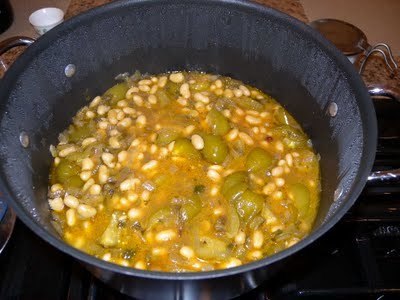
Here's the original recipe with my notations. I made it with the beans as a vegetarian dish, but the recipe also says you can used cooked chicken. Or, I would imagine, any other meat of choice.
4 poblano chiles (I used Anaheims)
1 T olive oil
1 large onion, cut into ¼ inch dice
2 jalapeño chiles, seeded & minced (Mine were huge, so I used one. Heat varies from one pepper to the next. You might want to sample a bit to decide how much you want to use)
3 garlic cloves, crushed
½ c packed fresh cilantro, chopped (Substituted a little chopped parsley; I don't like cilantro)
1 t cumin
¾ t salt
2 lb tomatillos, husked, rinsed and cut into quarters or eighths if large (see note and pictures below)
1 can vegetable broth
2 cans (15-19 oz each) white kidney beans,(My store only had Great Northerns) rinsed & drained
(or 12 oz. cooked chicken)
Roast poblano peppers, peel and cut into 1 inch pieces. (I also discovered during my research that poblanos and Anaheims are the chiles used for those cans of green chiles, so feel free to avoid all this work and use those. I probably will next time!)

To roast the peppers, put them in a hot (425) oven for about 30-45 minutes, until the skins are blistered. Then put them in either a paper bag or a bowl with a cover so the steam helps separate the peppers from the skin. Or, you can grill them or just stick them right on the burner if you have a gas stove. Or open a can!
Tomatillos aren't tomatoes at all. Like tomatoes, they're in the nightshade family, but they're more closely related to cape gooseberries
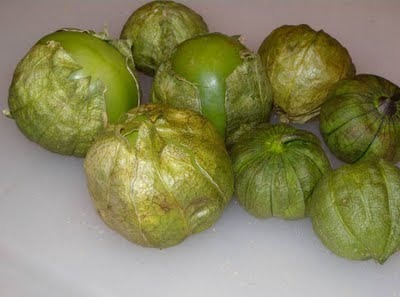
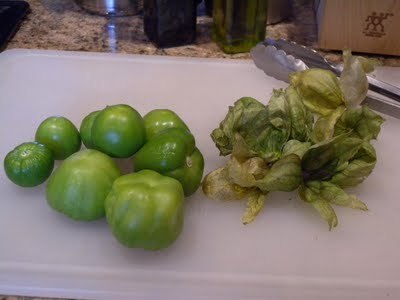
You have to peel the husk off and then wash them until they're not so sticky. There's kind of a foamy residue, so when the water is just about clear, I figure that's enough.
In 6 quart Dutch oven, heat oil over medium heat until hot. Add onion, jalapeños, garlic, cilantro, cumin and salt. Cook 5 minutes.
Stir in tomatillos, broth and roasted peppers; heat to boiling over high heat.
Reduce heat to low; comer and simmer 20 minutes or until tomatillos are tender. Stir in beans and cook 5 minutes longer until heated through.
Followup - since this recipe is designed to serve 8, and there are only the two of us, I figured we'd have enough for at least two meals. But I decided that for the next go-round, I'd change it up a bit. So, I made some pasta (little tube thingies) and then combined that with the leftover chili and some cheese and baked it in the oven until everything was hot and the cheese was melted. A great casserole.
Like this post? Please share by clicking one of the links below.
Thanks to Cicily for yesterday's most informative post.
The other day, I wanted to make this recipe for New Mexico Green Chili. However, I didn't have all the ingredients, and I was only willing to go as far as the local grocery store in Divide. When I couldn't find poblano chiles, I used what they had: Anaheim. And, after a little time with Google and Facebook, I determined they'd be acceptable substitutes.

Here's the original recipe with my notations. I made it with the beans as a vegetarian dish, but the recipe also says you can used cooked chicken. Or, I would imagine, any other meat of choice.
4 poblano chiles (I used Anaheims)
1 T olive oil
1 large onion, cut into ¼ inch dice
2 jalapeño chiles, seeded & minced (Mine were huge, so I used one. Heat varies from one pepper to the next. You might want to sample a bit to decide how much you want to use)
3 garlic cloves, crushed
½ c packed fresh cilantro, chopped (Substituted a little chopped parsley; I don't like cilantro)
1 t cumin
¾ t salt
2 lb tomatillos, husked, rinsed and cut into quarters or eighths if large (see note and pictures below)
1 can vegetable broth
2 cans (15-19 oz each) white kidney beans,(My store only had Great Northerns) rinsed & drained
(or 12 oz. cooked chicken)
Roast poblano peppers, peel and cut into 1 inch pieces. (I also discovered during my research that poblanos and Anaheims are the chiles used for those cans of green chiles, so feel free to avoid all this work and use those. I probably will next time!)

To roast the peppers, put them in a hot (425) oven for about 30-45 minutes, until the skins are blistered. Then put them in either a paper bag or a bowl with a cover so the steam helps separate the peppers from the skin. Or, you can grill them or just stick them right on the burner if you have a gas stove. Or open a can!
Tomatillos aren't tomatoes at all. Like tomatoes, they're in the nightshade family, but they're more closely related to cape gooseberries


You have to peel the husk off and then wash them until they're not so sticky. There's kind of a foamy residue, so when the water is just about clear, I figure that's enough.
In 6 quart Dutch oven, heat oil over medium heat until hot. Add onion, jalapeños, garlic, cilantro, cumin and salt. Cook 5 minutes.
Stir in tomatillos, broth and roasted peppers; heat to boiling over high heat.
Reduce heat to low; comer and simmer 20 minutes or until tomatillos are tender. Stir in beans and cook 5 minutes longer until heated through.
Followup - since this recipe is designed to serve 8, and there are only the two of us, I figured we'd have enough for at least two meals. But I decided that for the next go-round, I'd change it up a bit. So, I made some pasta (little tube thingies) and then combined that with the leftover chili and some cheese and baked it in the oven until everything was hot and the cheese was melted. A great casserole.
Like this post? Please share by clicking one of the links below.
Published on September 14, 2011 04:00
September 13, 2011
Unsolicited Advice
Today my guest is Cicily Janus. As a published author, a journalist and sleep deprived intern for one of the best agencies on the planet, Cicily would like to think that maybe, just maybe, that her unsolicited advice helps others.
Being a published author, I was hesitant to tell people, mainly other writers, that I wanted to move over to the dark side. The agent side. Trust me, this isn't some kind of power-trip. I honestly wanted to help writers become successful in their goals.
The question was, how to do this without losing myself and becoming, what much of the writing world considers agents, a member of the dark forces. To tell the truth, there wasn't a way around it.
Let me explain.
This process has afforded me considerable perspective as a writer. When I set out on this journey I was optimistic that good writers were in abundance. But after working for two of the best agents in the country for over two years, I've learned that it isn't about being good, it's about being sparklingly impressive from word one in both your query and MS.
These days the market is overly saturated. The effect it has on agents (and their interns) is this: We're simply unable to give feedback, advice or anything BUT a form rejection. So...here's a new angle on agents. Over one year I rejected 3,000+ writers. Among these: 90% were form rejections, 9% didn't follow published rules for queries and 1% had pages requested. Of that 1%, only one...and that's one person...was signed. So I began to ask myself, how do writers go from good to great?
In that year, I read page after page of brilliant writing that went nowhere. Believe me, I felt just as rejected when I presented a book I loved to my mentor and he said NO.
The majority of writers submitting have absolutely no clue on what it takes to land an agent. Concepts are either absent or muddled among mindless drivel in query letters. People quote family members for blurbs and consider letters to the editor as publishing credits. Correctly written sentences WITH correct punctuation and spelling, it seems, is too much to ask.
This is when I knew I crossed over into the darkness. Instead of finding something good enough to even offer helpful feedback, I found every possible reason to hate the writing.
When you're attempting to launch a career off of someone else's lap, whether you're an agent or a writer, you must know exactly what you're doing. Especially when oil is negligible and sludge is abundant and the money to be made is absent. Agents are very competitive and WANT you to be brilliant.
But the hardest lesson learned was this: regardless of how much I love a writer, if the work isn't marketable, I don't eat...starving makes me cranky. This crankiness is often passed down to the slush pile. Love the writing...good for you...sell the writing...good for everyone! It is now my JOB to find works that can feed us all. Writing has to be sans major issues (i.e. POV, style, grammar, concept) and the market has to be obvious. Then and only then, can it be considered for sale. The concept of not only selling great writing, but a package deal including author, voice and style, is what you have to take into account with every query and manuscript read as an agent. If only one of those components is missing, your paycheck gets docked.
So when you're querying for the novel you've lost blood, sweat and tears over, be mindful of who's receiving it. It's not the easiest of jobs and our livelihood depends on you, the writer.
Of course, you must confront reality. Writers are a dime a dozen. I know this because I'm one of them. Don't put yourself out there unless you know you're worth more than the dime next to you.
In my spare time…I own a nifty little business known as Writing Away Retreats and pen books like: The New Face of Jazz ). I'm found, oftentimes, listening to new jazz cats, or drooling around my Facebook page, asking folks for money at Williams Sonoma or signing books at Black Cat Books in Manitou Springs, CO.
For more from Cicily, you can find her at her blog or Writing Away Retreats , or at The New Face of Jazz .
Like this post? Please share by clicking one of the links below.
Being a published author, I was hesitant to tell people, mainly other writers, that I wanted to move over to the dark side. The agent side. Trust me, this isn't some kind of power-trip. I honestly wanted to help writers become successful in their goals.
The question was, how to do this without losing myself and becoming, what much of the writing world considers agents, a member of the dark forces. To tell the truth, there wasn't a way around it.
Let me explain.
This process has afforded me considerable perspective as a writer. When I set out on this journey I was optimistic that good writers were in abundance. But after working for two of the best agents in the country for over two years, I've learned that it isn't about being good, it's about being sparklingly impressive from word one in both your query and MS.
These days the market is overly saturated. The effect it has on agents (and their interns) is this: We're simply unable to give feedback, advice or anything BUT a form rejection. So...here's a new angle on agents. Over one year I rejected 3,000+ writers. Among these: 90% were form rejections, 9% didn't follow published rules for queries and 1% had pages requested. Of that 1%, only one...and that's one person...was signed. So I began to ask myself, how do writers go from good to great?
In that year, I read page after page of brilliant writing that went nowhere. Believe me, I felt just as rejected when I presented a book I loved to my mentor and he said NO.
The majority of writers submitting have absolutely no clue on what it takes to land an agent. Concepts are either absent or muddled among mindless drivel in query letters. People quote family members for blurbs and consider letters to the editor as publishing credits. Correctly written sentences WITH correct punctuation and spelling, it seems, is too much to ask.
This is when I knew I crossed over into the darkness. Instead of finding something good enough to even offer helpful feedback, I found every possible reason to hate the writing.
When you're attempting to launch a career off of someone else's lap, whether you're an agent or a writer, you must know exactly what you're doing. Especially when oil is negligible and sludge is abundant and the money to be made is absent. Agents are very competitive and WANT you to be brilliant.
But the hardest lesson learned was this: regardless of how much I love a writer, if the work isn't marketable, I don't eat...starving makes me cranky. This crankiness is often passed down to the slush pile. Love the writing...good for you...sell the writing...good for everyone! It is now my JOB to find works that can feed us all. Writing has to be sans major issues (i.e. POV, style, grammar, concept) and the market has to be obvious. Then and only then, can it be considered for sale. The concept of not only selling great writing, but a package deal including author, voice and style, is what you have to take into account with every query and manuscript read as an agent. If only one of those components is missing, your paycheck gets docked.
So when you're querying for the novel you've lost blood, sweat and tears over, be mindful of who's receiving it. It's not the easiest of jobs and our livelihood depends on you, the writer.
Of course, you must confront reality. Writers are a dime a dozen. I know this because I'm one of them. Don't put yourself out there unless you know you're worth more than the dime next to you.
In my spare time…I own a nifty little business known as Writing Away Retreats and pen books like: The New Face of Jazz ). I'm found, oftentimes, listening to new jazz cats, or drooling around my Facebook page, asking folks for money at Williams Sonoma or signing books at Black Cat Books in Manitou Springs, CO.
For more from Cicily, you can find her at her blog or Writing Away Retreats , or at The New Face of Jazz .
Like this post? Please share by clicking one of the links below.
Published on September 13, 2011 05:00
September 12, 2011
Research: Too Much or Too Little
What I'm reading: No More Bull, by John Sharpe
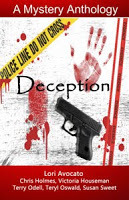 First – after many delays, DECEPTION, a mystery anthology including one of my short stories, is available for sale at
Amazon
,
Books a Million
, and Barnes & Noble.
First – after many delays, DECEPTION, a mystery anthology including one of my short stories, is available for sale at
Amazon
,
Books a Million
, and Barnes & Noble.
Format: trade paperback.
You can read more of my contribution here
We now return you to your regularly scheduled blog post:
I've been reading manuscripts for a contest recently, submitted by unpublished authors. I've noticed a problem that I think is worth sharing. Research. Too much or too little.
Everyone's heard it: Write What You Know. But what does that really mean? Do you have to be a cop or PI to write a detective story? Can you write about a chef if you can barely boil water? If you're a firefighter, is that all you can write about?
Now, having the inside skinny on the workings of any profession, craft, or lifestyle will add depth and color to your work. Most of the time, agents and editors will want to know why you're the one who can write the book. They love platforms.
But it's not a hard and fast requirement. It's a matter of learning enough to keep things on the page accurate within the realm of fiction. And sometimes knowing too much can hurt your writing more than it helps. Two things to remember:
1. Don't write things you haven't researched.
2. Don't overwhelm your reader with what you know.
If what you're putting on the page is in an authorial voice, then you don't need it. At least not so it's obvious. The reader shouldn't feel like you've shifted gears when you shift from describing things you know a lot about, whether first-hand or from diligent research. It's your characters who have to relay this information to the reader. But even if your characters are remaining 100% true to the language and descriptions of the scenario, if what you're putting on the page is there because you're showing your readers your expertise, but isn't moving the plot forward, you don't need it.
I can remember, long, long, long ago, when we were first married, and my husband and the husband of one of our neighbors would talk photography. Hubster was working on his PhD and took lots and lots and lots of pictures of his subject matter (seals and sea lions, if you're interested). Our neighbor worked in a camera shop.
As our neighbor's wife put it—"Photographers talk in numbers." Which, if you listen in, is pretty much what it sounds like. "F8 at 1/60th." (There weren't many automatic cameras in those days, and you did have to learn about F-stops and shutter speeds.) But to the outsider, no matter how animated the discussion, it was boring . You don't want to bore your readers.
The flip side – not doing enough research. (Insert my "Don't thumb the safety off a Glock" lecture here!) Do you know enough about your subject matter to fill in those "color" details? Climate? Architecture? The right trees? Local terminology or speech patterns? Depending on where you live, you might be drinking pop, cola, or soda.
Or maybe your character has a dog, and she brings it with her to a restaurant. Is it legal in the setting of your book? Do you know the difference between a police officer and a deputy? The hardest part of research is knowing what you don't know so you can look it up.
You can get your information from the Internet, but you can also talk to people. When I was drafting my proposal that included the discovery of a dead body, I emailed the police department in the nearest city. The person answering my emails was delighted to give me more details than I could ever use (see 'too much research' above!) and was happy to answer my follow up questions as well.
In the same way we don't follow our characters through the story minute-by-minute, we have to learn how to distill our facts so everything on the page has a reason for being there, and that whatever we do put on the page is as accurate as we can make it.
Tomorrow my guest is Cicily Janus who's got some excellent insights into what agents look for in a submission.
Like this post? Please share by clicking one of the links below.
 First – after many delays, DECEPTION, a mystery anthology including one of my short stories, is available for sale at
Amazon
,
Books a Million
, and Barnes & Noble.
First – after many delays, DECEPTION, a mystery anthology including one of my short stories, is available for sale at
Amazon
,
Books a Million
, and Barnes & Noble.Format: trade paperback.
You can read more of my contribution here
We now return you to your regularly scheduled blog post:
I've been reading manuscripts for a contest recently, submitted by unpublished authors. I've noticed a problem that I think is worth sharing. Research. Too much or too little.
Everyone's heard it: Write What You Know. But what does that really mean? Do you have to be a cop or PI to write a detective story? Can you write about a chef if you can barely boil water? If you're a firefighter, is that all you can write about?
Now, having the inside skinny on the workings of any profession, craft, or lifestyle will add depth and color to your work. Most of the time, agents and editors will want to know why you're the one who can write the book. They love platforms.
But it's not a hard and fast requirement. It's a matter of learning enough to keep things on the page accurate within the realm of fiction. And sometimes knowing too much can hurt your writing more than it helps. Two things to remember:
1. Don't write things you haven't researched.
2. Don't overwhelm your reader with what you know.
If what you're putting on the page is in an authorial voice, then you don't need it. At least not so it's obvious. The reader shouldn't feel like you've shifted gears when you shift from describing things you know a lot about, whether first-hand or from diligent research. It's your characters who have to relay this information to the reader. But even if your characters are remaining 100% true to the language and descriptions of the scenario, if what you're putting on the page is there because you're showing your readers your expertise, but isn't moving the plot forward, you don't need it.
I can remember, long, long, long ago, when we were first married, and my husband and the husband of one of our neighbors would talk photography. Hubster was working on his PhD and took lots and lots and lots of pictures of his subject matter (seals and sea lions, if you're interested). Our neighbor worked in a camera shop.
As our neighbor's wife put it—"Photographers talk in numbers." Which, if you listen in, is pretty much what it sounds like. "F8 at 1/60th." (There weren't many automatic cameras in those days, and you did have to learn about F-stops and shutter speeds.) But to the outsider, no matter how animated the discussion, it was boring . You don't want to bore your readers.
The flip side – not doing enough research. (Insert my "Don't thumb the safety off a Glock" lecture here!) Do you know enough about your subject matter to fill in those "color" details? Climate? Architecture? The right trees? Local terminology or speech patterns? Depending on where you live, you might be drinking pop, cola, or soda.
Or maybe your character has a dog, and she brings it with her to a restaurant. Is it legal in the setting of your book? Do you know the difference between a police officer and a deputy? The hardest part of research is knowing what you don't know so you can look it up.
You can get your information from the Internet, but you can also talk to people. When I was drafting my proposal that included the discovery of a dead body, I emailed the police department in the nearest city. The person answering my emails was delighted to give me more details than I could ever use (see 'too much research' above!) and was happy to answer my follow up questions as well.
In the same way we don't follow our characters through the story minute-by-minute, we have to learn how to distill our facts so everything on the page has a reason for being there, and that whatever we do put on the page is as accurate as we can make it.
Tomorrow my guest is Cicily Janus who's got some excellent insights into what agents look for in a submission.
Like this post? Please share by clicking one of the links below.
Published on September 12, 2011 04:00
September 10, 2011
Remembrance
Please take a moment to remember the events and the lives lost on September 11, 2001.
It's been ten years.


It's been ten years.

Published on September 10, 2011 23:01
September 9, 2011
Friday Field Trip - Memorial Forest
First -- Happy 90th Birthday to my aunt, although she'll never see this because she wants nothing to do with computers. Happy Birthday anyway, and you should be getting flowers because you don't have a computer. Oh, I'd have sent them anyway, even if you DID have a computer. Love you.
Last Monday, not because it was Labor Day (when you're retired, empty-nesters and/or work from home, one day is exactly like any other--except for Tuesday being clean sheet day, and Wednesday being garbage pick up day, Sunday being drinks at McGinty's, etc.), but because the weather was nice and we'd skipped our usual Sunday hike (which you can do if you're retired, empty-nesters and/or work from home) and headed out to a nearby Women's Memorial Forest, where I took pictures of Gnarly Things. Had I been Jason, they'd have been prettier, but I'm not, so you'll have to deal with my point and shoot, straight out of the camera (more or less) shots.
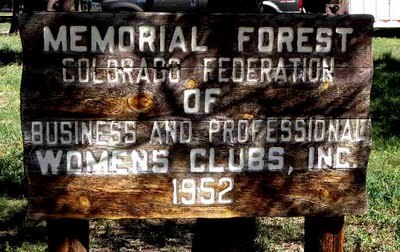



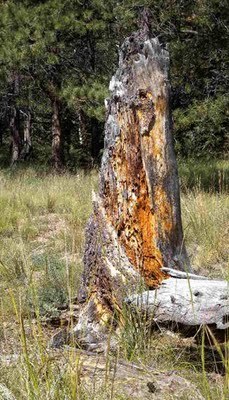



Like this post? Please share by clicking one of the links below.
Last Monday, not because it was Labor Day (when you're retired, empty-nesters and/or work from home, one day is exactly like any other--except for Tuesday being clean sheet day, and Wednesday being garbage pick up day, Sunday being drinks at McGinty's, etc.), but because the weather was nice and we'd skipped our usual Sunday hike (which you can do if you're retired, empty-nesters and/or work from home) and headed out to a nearby Women's Memorial Forest, where I took pictures of Gnarly Things. Had I been Jason, they'd have been prettier, but I'm not, so you'll have to deal with my point and shoot, straight out of the camera (more or less) shots.








Like this post? Please share by clicking one of the links below.
Published on September 09, 2011 04:00
September 8, 2011
Why Print?
What I'm reading: Dick Francis's Gamble by Felix Francis
I'm continuing my "All About Characters" seminar at Coffee Time Romance with a discussion of the various types of characters today: Stars, Supporting Cast, Extras, Walk-ons and Spear Carriers. Please drop by. But don't forget to come back.
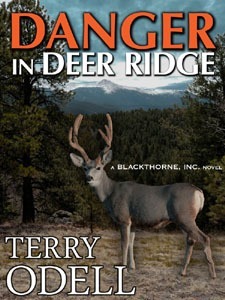 The big switch in publishing is into digital formats. Whereas a couple of years ago, people wanted to know if they could walk into a bookstore and buy my books, today I'm more likely to hear, "Is it on the Kindle?"
The big switch in publishing is into digital formats. Whereas a couple of years ago, people wanted to know if they could walk into a bookstore and buy my books, today I'm more likely to hear, "Is it on the Kindle?"
Side note: As a NOOK color owner, I don't really like the idea that everyone assumes an e-book reader is Kindle, but I think it's slowly becoming generic…kind of like Kleenex. But there ARE other readers.
When I decided to bypass the publisher for DANGER IN DEER RIDGE, another Blackthorne, Inc. novel, I formatted it for every digital outlet I could handle. Barnes & Noble , Amazon , All Romance eBooks, and via Smashwords , also Sony, Apple, and more. I did it all myself, and I didn't find it too complicated, perhaps because I've been involved with publishers who required digital submissions. I knew enough about formatting a Word doc so I wasn't intimidated by the Smashwords formatting guidelines. And I definitely recommend starting there. Once you've mastered Smashwords, the rest is easy.
I also recommend the free program, Calibre , which will convert a document to most formats, since All Romance eBooks doesn't do the conversions the way the other shops do.
But I've digressed. I meant to talk about print books. I know there are still readers who want to read print. My mother, for example. Even though I know sales of my print version will be minuscule when compared with digital, the more formats, the more readers I can reach.
The cover art posed a minor challenge. Since it's an actual book, there has to be a front AND back cover, as well as a spine. Since I had a front cover, all I needed was a back cover and spine. But the dimensions are determined by Create Space (the longer your book, the bigger the spine will have to be), and they want a pdf file. I could handle that, but when they talked about layers, the cringes hit. However, thanks to my daughter who knows enough about Photoshop to deal with things like aspect ratios and creating a document from nothing (all I can do with Photoshop is crop images, resize them, and adjust things like color and contrast. Adding stuff that wasn't there, or taking out stuff that was isn't in my skill set), I got a cover for the perfect price. She ended up having to tweak the front cover a bit (that aspect ratio thing) but she kept it very close to the original. We went through a couple of trials before settling on the final cover.
Test #1 - just getting the feel of things:
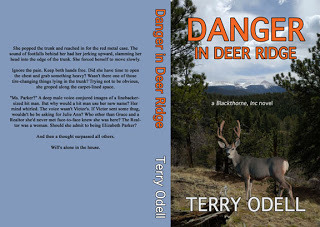
Making the spine and back more distinctive:
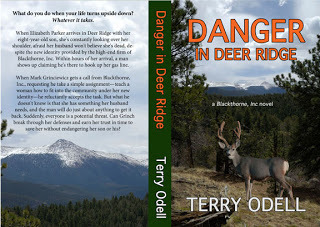
Decided blue looked better on the spine - final cover image:
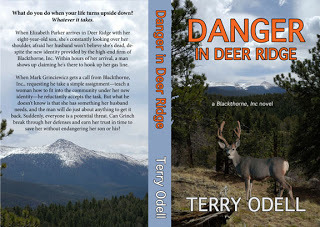
Next step is determining distribution which determines price. Since this is my first print endeavor, I didn't need to set up my own bookstore. Since I don't expect huge clamorings from bookstores, I don't need the "extended distribution." I don't need to deal with warehousing and shipping. All I wanted was to be able to say, "Yes, go to Amazon.com and you can buy my book."
The cost for this was $39, but the perks were higher royalties and lower price potential for both readers and authors. So, I can have a supply of books for book signings, AND I can keep the price at the Amazon store competitive. I decided to price DANGER IN DEER RIDGE at $10.99, which is low for a trade paperback, and only a little higher than a mass market paperback. Will I make a huge profit on each sale? No, but that wasn't my objective.
The last step is to purchase a proof (and, stupid me didn't remember that the welcome email I got when I first thought about Create Space and set up an account included a code for a free proof), I did pay a nominal fee to get a proof copy of the print book.
And, all in all, the quality is excellent. I sent a proof copy to my mother (thereby eliminating my one guaranteed sale). She called when it arrived, telling me she loved the crisp black ink on the white paper saying it was much easier to read than "regular" books.
So, that's why I chose to go print as well as digital, and a brief look at Create Space. If you have questions, I'll try to answer them.
How about you? What's your favorite format?
Tomorrow: Gnarly Things. You'll have to come back to see what I'm talking about.
Like this post? Please share by clicking one of the links below.
I'm continuing my "All About Characters" seminar at Coffee Time Romance with a discussion of the various types of characters today: Stars, Supporting Cast, Extras, Walk-ons and Spear Carriers. Please drop by. But don't forget to come back.
 The big switch in publishing is into digital formats. Whereas a couple of years ago, people wanted to know if they could walk into a bookstore and buy my books, today I'm more likely to hear, "Is it on the Kindle?"
The big switch in publishing is into digital formats. Whereas a couple of years ago, people wanted to know if they could walk into a bookstore and buy my books, today I'm more likely to hear, "Is it on the Kindle?" Side note: As a NOOK color owner, I don't really like the idea that everyone assumes an e-book reader is Kindle, but I think it's slowly becoming generic…kind of like Kleenex. But there ARE other readers.
When I decided to bypass the publisher for DANGER IN DEER RIDGE, another Blackthorne, Inc. novel, I formatted it for every digital outlet I could handle. Barnes & Noble , Amazon , All Romance eBooks, and via Smashwords , also Sony, Apple, and more. I did it all myself, and I didn't find it too complicated, perhaps because I've been involved with publishers who required digital submissions. I knew enough about formatting a Word doc so I wasn't intimidated by the Smashwords formatting guidelines. And I definitely recommend starting there. Once you've mastered Smashwords, the rest is easy.
I also recommend the free program, Calibre , which will convert a document to most formats, since All Romance eBooks doesn't do the conversions the way the other shops do.
But I've digressed. I meant to talk about print books. I know there are still readers who want to read print. My mother, for example. Even though I know sales of my print version will be minuscule when compared with digital, the more formats, the more readers I can reach.
The cover art posed a minor challenge. Since it's an actual book, there has to be a front AND back cover, as well as a spine. Since I had a front cover, all I needed was a back cover and spine. But the dimensions are determined by Create Space (the longer your book, the bigger the spine will have to be), and they want a pdf file. I could handle that, but when they talked about layers, the cringes hit. However, thanks to my daughter who knows enough about Photoshop to deal with things like aspect ratios and creating a document from nothing (all I can do with Photoshop is crop images, resize them, and adjust things like color and contrast. Adding stuff that wasn't there, or taking out stuff that was isn't in my skill set), I got a cover for the perfect price. She ended up having to tweak the front cover a bit (that aspect ratio thing) but she kept it very close to the original. We went through a couple of trials before settling on the final cover.
Test #1 - just getting the feel of things:

Making the spine and back more distinctive:

Decided blue looked better on the spine - final cover image:

Next step is determining distribution which determines price. Since this is my first print endeavor, I didn't need to set up my own bookstore. Since I don't expect huge clamorings from bookstores, I don't need the "extended distribution." I don't need to deal with warehousing and shipping. All I wanted was to be able to say, "Yes, go to Amazon.com and you can buy my book."
The cost for this was $39, but the perks were higher royalties and lower price potential for both readers and authors. So, I can have a supply of books for book signings, AND I can keep the price at the Amazon store competitive. I decided to price DANGER IN DEER RIDGE at $10.99, which is low for a trade paperback, and only a little higher than a mass market paperback. Will I make a huge profit on each sale? No, but that wasn't my objective.
The last step is to purchase a proof (and, stupid me didn't remember that the welcome email I got when I first thought about Create Space and set up an account included a code for a free proof), I did pay a nominal fee to get a proof copy of the print book.
And, all in all, the quality is excellent. I sent a proof copy to my mother (thereby eliminating my one guaranteed sale). She called when it arrived, telling me she loved the crisp black ink on the white paper saying it was much easier to read than "regular" books.
So, that's why I chose to go print as well as digital, and a brief look at Create Space. If you have questions, I'll try to answer them.
How about you? What's your favorite format?
Tomorrow: Gnarly Things. You'll have to come back to see what I'm talking about.
Like this post? Please share by clicking one of the links below.
Published on September 08, 2011 04:00
September 7, 2011
What's Cooking Wednesday, Multi-purpose Sauce
What I'm reading: Double Play, by Jill Shalvis
Thanks to Kelly for her reminder that we can't slack off even when we're the boss.
For today's cooking installment, I decided to go with something quick, easy, and versatile. My mom called this "Sauce for Vegetables" but it can be used for a lot more than that. Hubster grilled fish the other night, and because it was a very mild flavored fish, I decided to dress it up with this sauce.
As you can see here, there aren't a lot of ingredients. And you can increase, decrease, or swap things out as you prefer. It's kind of like my plotting style. A lot of improv. (If you look at the recipe card, you can see there's not a whole lot going on.)
Here's the "official" ingredient list, which you can clearly see in this picture:
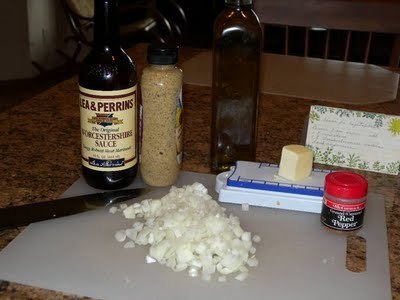
1 small onion, chopped (I used 1/2 a large one, because we like onions)
Butter or oil (not on Mom's card, but you have to brown the onion in something! Use what you like: I used olive oil and butter)
1 T. Worcestershire sauce
1 t. mustard
Dash cayenne (depends on your heat tolerance)
Here's what you do:
Brown the onion.
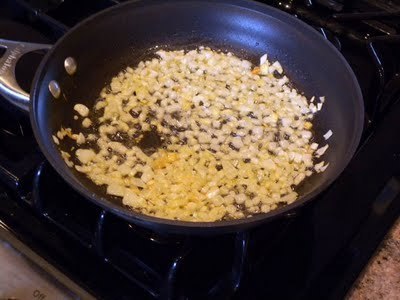
Add the rest.
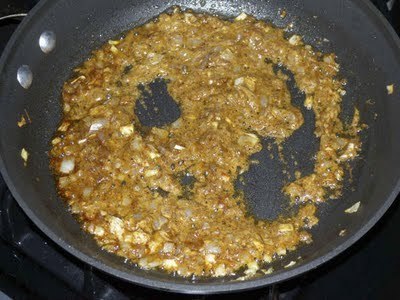
Mix into cooked vegetables. Mom used green beans most of the time. It doesn't make a whole lot, so if you're cooking for more than 2, I'd double the recipe.
Also, for my fish topper, at the end, I threw in a few glugs of white wine and let it reduce a bit.

Like this post? Please share by clicking one of the links below.
Thanks to Kelly for her reminder that we can't slack off even when we're the boss.
For today's cooking installment, I decided to go with something quick, easy, and versatile. My mom called this "Sauce for Vegetables" but it can be used for a lot more than that. Hubster grilled fish the other night, and because it was a very mild flavored fish, I decided to dress it up with this sauce.
As you can see here, there aren't a lot of ingredients. And you can increase, decrease, or swap things out as you prefer. It's kind of like my plotting style. A lot of improv. (If you look at the recipe card, you can see there's not a whole lot going on.)
Here's the "official" ingredient list, which you can clearly see in this picture:

1 small onion, chopped (I used 1/2 a large one, because we like onions)
Butter or oil (not on Mom's card, but you have to brown the onion in something! Use what you like: I used olive oil and butter)
1 T. Worcestershire sauce
1 t. mustard
Dash cayenne (depends on your heat tolerance)
Here's what you do:
Brown the onion.

Add the rest.

Mix into cooked vegetables. Mom used green beans most of the time. It doesn't make a whole lot, so if you're cooking for more than 2, I'd double the recipe.
Also, for my fish topper, at the end, I threw in a few glugs of white wine and let it reduce a bit.

Like this post? Please share by clicking one of the links below.
Published on September 07, 2011 04:00
September 6, 2011
Being Your Own Boss--The Downside of Indie Publishing
Today my guest is Kelly McClymer. She's written short science fiction, fantasy,historical romance and YA. After dipping a toe into the indie epublishing trade by bringing out her backlist, she found she liked the control, the income, and the (relatively) quick payment turnaround. Once she gets the business side ironed out, she'll be epublishing several indie original YA novels. And while Kelly is here, I'm over at Coffee Time Romance talking characters.
I know many people who dream of being their own bosses…until they are. And then they run screaming back to the world of 8 hour work days, regular paychecks and paid vacation days.
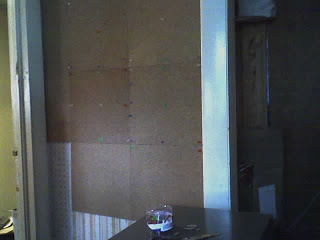 I've always had a mix of choose-your-own and follow-the-leader jobs. I find good things about both (a paycheck you can count on is very nice), but at heart I'm an entrepreneur. I want to do something new as soon as I've learned the old thing well enough. Writing is the only career that lets me do that, with the added advantage of allowing me to use what I've discovered working regular jobs.
I've always had a mix of choose-your-own and follow-the-leader jobs. I find good things about both (a paycheck you can count on is very nice), but at heart I'm an entrepreneur. I want to do something new as soon as I've learned the old thing well enough. Writing is the only career that lets me do that, with the added advantage of allowing me to use what I've discovered working regular jobs.
For years now, I've been pulling what I've learned from life and using it in books, some sold and some yet unsold and unfinished. Motherhood has informed a lot of my writing, but so has my first career as babysitter (perfect for a YA writer), my years working in the drug store, in various university offices, as a tutor for children with dyslexia, and as a temp employee. I always thought I was a good business person, though, and able to tend to the business side (deadlines, quality control, keeping myself out there for people to stumble over).
And then I started putting my backlist books out as ebooks. The learning curve was steep, and full of hair raising drops and rises, not to mention a hairpin turn or two. I ran a successful promotion and made good sales. I thought I was a good business person.
And then I stepped back, looked at the short stories and indie originals I wanted to bring out, and realized the full extent of the new business model I'd embraced. To my great horror, I realized there was one thing, and only one thing, I was terrified to tackle. Workflow.
Aiming for traditional publishing actually makes workflow very simple: you write the book until the point where you think it is ready to entice an agent/editor, then you query it, and keep on querying until it gets bought. Then the workflow decisions are handled by the publisher. They give you a deadline. Yes, you get a little input, but the publisher makes all the decisions about when the manuscript needs to be turned in to the editor, when the copyedits need to be done, when the cover art and pr and proofreading need to be done. They base all of this on the publication date they set. If one thing takes longer than scheduled, something else is speeded up to make that all important laydown date.
When you write for the indie market (i.e., act as your own publisher), all those decisions are yours. I'd brought out my backlist books without thinking in workflow terms dictated by a laydown date. I thought in terms of the workflow schedule I'd used for writing a book -- write, edit, revise, release. I had a lot of fun playing and learning. I even had fun throwing a big promotion for my daughter's wedding, and putting my backlist books up. But now the last backlist book (so far), The Next Best Bride, is out and thriving. I need to move to the next step of the plan. Indie originals.
I'd always known what novel I'd release next. But I realized just recently that I had to change to a publisher workflow model if I wanted to do it in the best way possible for the project. I needed a laydown date. Make that, I *need* a laydown date. And I'm afraid to set one. I think it comes from the writer's superstition that a book tells you when it is done, and it is dangerous to push it out before it is ready.
Which is too bad, because being an indie writer is business, and to do it well you need a laydown date, just like a publisher does.
So I wrote the following memo:
TO: Kelly the boss-ladyFROM: Kelly the writer-lady
SUBJECT: LAYDOWNS AND DEADLINES
Hey, Boss-Lady. Tell me when you're going to publish this book, so I can schedule the revision part to meet the deadline. And, by the way, make sure that the cover art, back cover blurb, and editorial work is factored into all of that.
Yours creatively,
Kelly
I have yet to hear back, but the way she's cursing through her office door, I expect she's figuring out all the little workflow deadlines and will let me know what I need to do soon.
When she does, I'll give her some chocolate, and promise to meet the deadline, no excuses. Because that's what a writer focused on business does. Even if she is tempted wants to run away screaming like a banshee.
You can find out more about Kelly-the-boss and Kelly-the-writer at Kelly's Blog http://kelly.mcclymer.com, on Facebook, or you can follow her on Twitter or Google+.
Like this post? Please share by clicking one of the links below.
I know many people who dream of being their own bosses…until they are. And then they run screaming back to the world of 8 hour work days, regular paychecks and paid vacation days.
 I've always had a mix of choose-your-own and follow-the-leader jobs. I find good things about both (a paycheck you can count on is very nice), but at heart I'm an entrepreneur. I want to do something new as soon as I've learned the old thing well enough. Writing is the only career that lets me do that, with the added advantage of allowing me to use what I've discovered working regular jobs.
I've always had a mix of choose-your-own and follow-the-leader jobs. I find good things about both (a paycheck you can count on is very nice), but at heart I'm an entrepreneur. I want to do something new as soon as I've learned the old thing well enough. Writing is the only career that lets me do that, with the added advantage of allowing me to use what I've discovered working regular jobs.For years now, I've been pulling what I've learned from life and using it in books, some sold and some yet unsold and unfinished. Motherhood has informed a lot of my writing, but so has my first career as babysitter (perfect for a YA writer), my years working in the drug store, in various university offices, as a tutor for children with dyslexia, and as a temp employee. I always thought I was a good business person, though, and able to tend to the business side (deadlines, quality control, keeping myself out there for people to stumble over).
And then I started putting my backlist books out as ebooks. The learning curve was steep, and full of hair raising drops and rises, not to mention a hairpin turn or two. I ran a successful promotion and made good sales. I thought I was a good business person.
And then I stepped back, looked at the short stories and indie originals I wanted to bring out, and realized the full extent of the new business model I'd embraced. To my great horror, I realized there was one thing, and only one thing, I was terrified to tackle. Workflow.
Aiming for traditional publishing actually makes workflow very simple: you write the book until the point where you think it is ready to entice an agent/editor, then you query it, and keep on querying until it gets bought. Then the workflow decisions are handled by the publisher. They give you a deadline. Yes, you get a little input, but the publisher makes all the decisions about when the manuscript needs to be turned in to the editor, when the copyedits need to be done, when the cover art and pr and proofreading need to be done. They base all of this on the publication date they set. If one thing takes longer than scheduled, something else is speeded up to make that all important laydown date.
When you write for the indie market (i.e., act as your own publisher), all those decisions are yours. I'd brought out my backlist books without thinking in workflow terms dictated by a laydown date. I thought in terms of the workflow schedule I'd used for writing a book -- write, edit, revise, release. I had a lot of fun playing and learning. I even had fun throwing a big promotion for my daughter's wedding, and putting my backlist books up. But now the last backlist book (so far), The Next Best Bride, is out and thriving. I need to move to the next step of the plan. Indie originals.
I'd always known what novel I'd release next. But I realized just recently that I had to change to a publisher workflow model if I wanted to do it in the best way possible for the project. I needed a laydown date. Make that, I *need* a laydown date. And I'm afraid to set one. I think it comes from the writer's superstition that a book tells you when it is done, and it is dangerous to push it out before it is ready.
Which is too bad, because being an indie writer is business, and to do it well you need a laydown date, just like a publisher does.
So I wrote the following memo:
TO: Kelly the boss-ladyFROM: Kelly the writer-lady
SUBJECT: LAYDOWNS AND DEADLINES
Hey, Boss-Lady. Tell me when you're going to publish this book, so I can schedule the revision part to meet the deadline. And, by the way, make sure that the cover art, back cover blurb, and editorial work is factored into all of that.
Yours creatively,
Kelly
I have yet to hear back, but the way she's cursing through her office door, I expect she's figuring out all the little workflow deadlines and will let me know what I need to do soon.
When she does, I'll give her some chocolate, and promise to meet the deadline, no excuses. Because that's what a writer focused on business does. Even if she is tempted wants to run away screaming like a banshee.
You can find out more about Kelly-the-boss and Kelly-the-writer at Kelly's Blog http://kelly.mcclymer.com, on Facebook, or you can follow her on Twitter or Google+.
Like this post? Please share by clicking one of the links below.
Published on September 06, 2011 05:00



